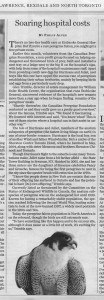Soaring hospital costs
There’s no two-tier health care at Etobicoke General Hospital.
But if you’re a rare peregrine falcon, you might get a free private room.
Earlier this month, volunteers from the Canadian Peregrine Foundation, a non-profit group focused on helping endangered and threatened birds of prey, built and installed a nest tray on a ledge next to the big H on the hospital’s sign, with help from some of the hospital’s maintenance staff. Apart from providing comfy new digs for Hurricane and Juliet, nest trays like this one have upped the success rate of peregrines establishing their urban territories, mainly by keeping birds and eggs from a particularly nasty drop.
Glen Trimble, director of estate management for William Osler Health Centre, the organization that runs Etobicoke General, uncovered evidence of the hospital’s new tenants more than a year ago when he began finding remains of the peregrines’ meals.
“Shortly thereafter, the Canadian Peregrine Foundation contacted us and they really gave us a pretty good overview,” about the falcons, Trimble says. “We found it fascinating. … We listened with interest and said, ‘You know what? This is one of those stories where a hospital can in fact assist in another way.’ ”
The tale of Hurricane and Juliet, members of the anatum subspecies of peregrine (the fastest living things on earth) is one of cross-border romance. Hurricane is the local boy, son of mother Wind and father Windwhistler. He’s a native of the Sheraton Centre Toronto Hotel, where he hatched in May, 2004, along with sister Monsoon and brothers Sheraton-Chinook and Tornado.
Though Hurricane’s flight to the suburbs is one many Torontonians make, Juliet came from a bit farther afield – the State Tower Building in Syracuse, N.Y. Hatched in 2005, she and her three sisters are the daughters of Syracuse celebrities Fancy and Groucho, famous for being the first peregrines to nest in the city since the species’ brush with extinction in the 1970s.
“I know the people down in New York are ecstatic that one of their offspring has surfaced in Ontario and has the potential to have [its] own offspring,” Trimble says.
Currently listed as threatened by the Committee on the Status of Endangered Wildlife in Canada, the anatum subspecies of peregrine was on the endangered list until 1999. Known for having a remarkably stable population, the species crashed following the Second World War, leading scientists to look at the now-banned DDT, a widely used pesticide in the 1950s and ’60s.
Today, the peregrine falcon population in North America is on the rebound, though the birds are still extremely rare.
“To have something like this happen and to be on your site, although it does cause us a little bit of work, it’s exciting for us,” Trimble says.
National Post Saturday, April 21, 2007 Page: TO4 Section: Toronto: The City Byline: Philip Alves Column: Neighbourhoods: Rexdale
